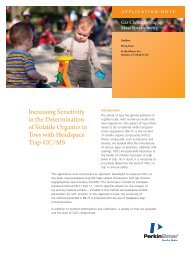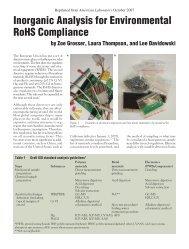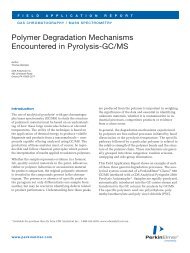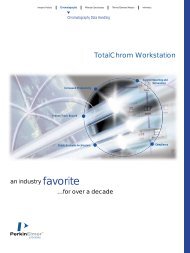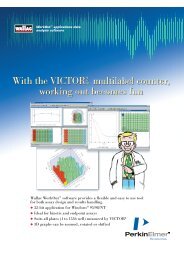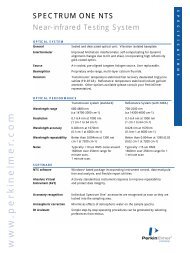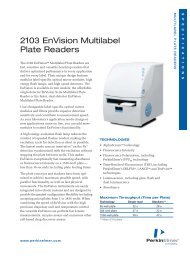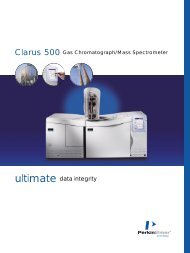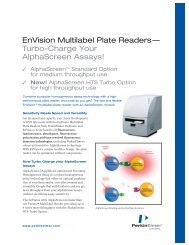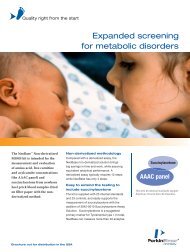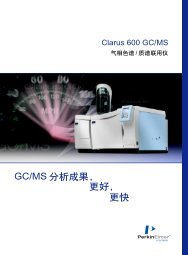DELFIA® GTP-binding kit AD0167 - PerkinElmer
DELFIA® GTP-binding kit AD0167 - PerkinElmer
DELFIA® GTP-binding kit AD0167 - PerkinElmer
Create successful ePaper yourself
Turn your PDF publications into a flip-book with our unique Google optimized e-Paper software.
PRINCIPLES OF THE ASSAYThe DELFIA <strong>GTP</strong>-<strong>binding</strong> assay is a time-resolvedfluorometric assay based on GDP-<strong>GTP</strong> exchange onG-protein subunits followed by GPCR activation byagonists. All membrane preparations need differentconditions for <strong>GTP</strong>-<strong>binding</strong>. This <strong>kit</strong> provides the instructionsand tools for optimizing the conditions for usewith a membrane preparation. After optimization the <strong>kit</strong>reagents can be used for screening novel agonists.This <strong>kit</strong> is the first non-radioactive <strong>GTP</strong>-<strong>binding</strong> assay forthe screening of new agonists. Once the assay conditionshave been optimized for use with the membrane preparation,screening is fast and easy to perform:REFERENCES1. Jansson et al. (1999): Alpha2-adrenoceptoragonists stimulate high-affinity <strong>GTP</strong>ase activityin a receptor subtype selective manner. Eur. J.Pharmacol. 374(1), 137–146.2. Peltonen, J. M., Pihlavisto, M. and Scheinin, M.(1998): Subtype-specific stimulation of [ 35 S]<strong>GTP</strong>gammaS <strong>binding</strong> by recombinant alpha2-adrenoceptors. Eur. J. Pharmacol. 355(2-3),275–279.3. Tian, W. N., Duzic, E., Lanier, S. M. (1994):Determinants of alpha 2-adrenergic receptoractivation of G proteins: evidence for a precoupledreceptor/G protein state. Mol Pharmacol.45(3), 524–531.4. Frang, H., Mukkala, V-M., Syystö, R., Ollikka,P., Hurskainen, P., Scheinin, M. and Hemmilä,I. (2003): Nonradioactive <strong>GTP</strong> Binding Assay toMonitor Activation of G Protein-Coupled Receptors.Assay and Drug Development Technologies1(2), 275–280.445
GDP-<strong>GTP</strong> exchange also takes place continuously inthe absence of GPCR activation. The assay is thereforeperformed with and without agonist to determinethe basal activation. The actual <strong>GTP</strong>-Eu <strong>binding</strong> signalcaused by agonist stimulation (= b) is comparedto basal <strong>binding</strong> (= a) and the final result is calculatedas % over basal <strong>binding</strong> [% over basal = (b/a x 100) –100].<strong>GTP</strong>-Eu is autofluorescent, so there is no need for anenhancement step: the plate is ready to be measuredimmediately after washing.KIT CONTENTSThe reagents are sufficient for 960 wells.Step 5: Dose–response% over basal <strong>binding</strong>6004503001500-13 -12 -11 -10 -9 -8 -7 -6 -5Motilin (M)The manufacturing date of the complete package isstated on the outer label. Store at +2 - +8°C. NOTE!All of the reagents are shipped at +2 - +8°C, butafter dissolving, the <strong>GTP</strong>-Eu, GDP and <strong>GTP</strong>-g-Shave to be stored at -20°C as stated in the section"PREPARATION OF REAGENTS".643
Step 3: Saponin testing on membranesReagents1500Component Quantity Storage and shelf life<strong>GTP</strong>-Eu <strong>binding</strong>(% over basal)100050000 250 500 750 1000 1250Saponin (µg/mL)<strong>GTP</strong>-Eu(1.65 nmol)1 vial, lyophilized+2 - +8°CThe lyophilized <strong>GTP</strong>-Eu contains Tris-HCl, Dextran T-40 andbovine serum albumin.<strong>GTP</strong>-g-S(275 nmol)1 vial, lyophilized+2 - +8°C .Step 4: Testing the amount of membraneThe lyophilized <strong>GTP</strong>-g-S contains Tris-HCl, Dextran T-40 andbovine serum albumin.750GDP(2.2 µmol)1 vial, lyophilized+2 - +8°C .<strong>GTP</strong>-Eu <strong>binding</strong>(% over basal)50025000 1 4 7 10 13Membrane protein (µg/well)The lyophilized GDP contains Tris-HCl, Dextran T-40 and bovineserum albumin.250 mM HEPESBuffer1 bottle,50 mLHEPES Buffer (pH 7.4)+2 - +8°C .427
10x <strong>GTP</strong> Wash Solution1 bottle, 250 mL +2 - +8°C .TYPICAL RESULTS FROM OPTIMIZATION STEPSThese optimizations have been performed for humanmotilin receptor (HEK293 cells, G i coupled receptor).The agonist used was motilin.A 10-fold concentration of wash solution containing Tris-HCland MgCl 2 .Step 1: MgCl 2 and GDP testing on membranes50 mg/mL Saponin 1 vial, 3 mL +2 - +8°C120A detergent containing Saponin and distilled water.1 M MgCl 2 2 vials, 2.5 mL +2 - +8°C .<strong>GTP</strong>-Eu <strong>binding</strong>(% over basal)1008060402000.1 1GDP (µM)310110MgCl 2(mM)Step 2: NaCl testing on membranes5 M NaCl 2 vials, 3 mL +2 - +8°C .100Sodium chloride dissolved in distilled water.AcroWell FilterPlate10 pcs Room temperature(+20 - +25°C)<strong>GTP</strong>-Eu <strong>binding</strong>(% over basal)755025AcroWell is a trademark of Pall Corporation.800 20 50 100 200NaCl (mM)41
10. DTT may increase the % over basal valueswith some G-protein coupled receptors.11. <strong>GTP</strong>-<strong>binding</strong> assay can be miniaturized to384-format (AcroPrep 384 Filter Plate, shorttips from Pall Life Sciences, prod. no. 5071).CALCULATION OF RESULTS1. Calculate the average counts for each set oftriplicate wells. If the non-specific <strong>binding</strong> (NSB)values differ between different areas of the platewhen performing the dose–response curve, theyshould be subtracted. If the NSB values are morethan 20% of basal values, pay special attention tothe thoroughness of filtration.2. Calculate the percent over basal for knownagonist and screened compounds.% overbasal =Stimulated signal (average) x 100Basal signal (average)- 1003. The results of optimization steps may be interpretedby plotting % over basal signals as a functionof the tested buffer component or membranepreparation concentration.4. A dose–response curve may be generated by plotting% over basal as a function of the log agonistconcentration.MATERIALS REQUIRED BUT NOT SUPPLIED WITHTHE KITThe DELFIA system requires the following items, whichare available from <strong>PerkinElmer</strong> Life and Analytical Sciencesor its distributors.1. Time-resolved fluorometer, e.g. 1420 VICTOR MultilabelCounter or 2101 EnVision Multilabel Reader2. Automatic shaker - DELFIA Plateshake (prod. no.1296-003/004)3. Pipette for dispensing the diluted <strong>GTP</strong> Wash Solution- Eppendorf Multipette (prod. no. 1296-014)with 5 mL Combitips (prod. no. 1296-016)In addition, the following are required:− filter plate washing manifold: Multiscreen VacuumManifold, Millipore− membrane preparation from cell line expressing G i -protein coupled receptor (see reference 1 for asuggested membrane preparation)− agonist for a detected receptor− precision pipettes for dispensing microliter volumes− pipettes for dispensing milliliter volumes− glass or polypropylene tubes−−distilled waterplate tape for covering the empty wells during thewashesWARNINGS AND PRECAUTIONSThis DELFIA <strong>GTP</strong>-<strong>binding</strong> <strong>kit</strong> is intended for researchuse only.Disposal of all waste should be in accordance with localregulations.AcroPrep is a trademark of Pall Corporation.40VICTOR and EnVision are trademarks of <strong>PerkinElmer</strong>, Inc.9
PREPARATION OF REAGENTSReagent<strong>GTP</strong>-EuReconstituted stabilityAliquot and store at -20°C.Stable at -20°C for 4 months.Reconstitute the lyophilized <strong>GTP</strong>-Eu by adding 165 µL of distilledwater to yield a <strong>GTP</strong>-Eu concentration of 10 µmol/L andmix gently. Allow to stand for approx. 30 minutes before use.When using the dissolved <strong>GTP</strong>-Eu make only the requiredamount of 1 : 100 dilution as stated in the instructions. Keepthe dilution on ice. This dilution is also stable at room temperaturefor 4 hours.GDPAliquot and store at -20°C.Stable at -20°C for 4 months.Reconstitute the lyophilized GDP by adding 1.1 mL of distilledwater to yield a GDP concentration of 2 mmol/L and mix gently.Allow to stand for approx. 30 minutes before use. Whenusing the dissolved GDP keep it on ice.<strong>GTP</strong>-g-SAliquot and store at -20°C.Stable at -20°C for 4 months.Reconstitute the lyophilized <strong>GTP</strong>-g-S by adding 1.1 mL ofdistilled water to yield a <strong>GTP</strong>-g-S concentration of 250 µmol/Land mix gently. Allow to stand for approx. 30 minutes beforeuse.When using the dissolved <strong>GTP</strong>-g-S make only the requiredamount of 1 : 5 dilution with 50 mM HEPES buffer and keep iton ice. This dilution is also stable at room temperature for 4hours.3. Frozen specimens should be thawed slowly andgently mixed by hand. Do not vigorously vortex ormix samples. DO NOT HOMOGENIZE THE MEM-BRANE PREPARATION MECHANICALLY AF-TER THAWING.4. When filtering the plates, ensure that each well iswashed completely by using diluted <strong>GTP</strong> WashSolution. After washing the plates, check that thewells are dry. Remove any remaining moisture byblotting the plate on absorbent paper.5. If the AcroWell Filter Plate is not fitting tightly onthe Millipore manifolder/vacuum unit, remove themetal grid from the top of the frame. The blackrubber part should, however, be left on the framein order to prevent problems with vacuum leakage.With this small remodeling, the AcroWellplate will fit better on the Millipore manifolder/vacuum frame.6. Covering the unused wells with plate tape mayimprove filtration. Another option is to wash all ofthe wells at the same time if you are not planningto use the unused wells in the future.7. When filtering the plates use vacuum pressurebelow 500 mbar and avoid rapid pressurechanges to prevent leakage of the plates. Vacuumpressure of 300 mbar is suitable for most cases.8. Measure the plates within 30 minutes of filtration.If you are not able to do so, measure the plateafter 6 hours or when the plate has completelydried. Unevenly dried plate increases signal variation.9. Use DELFIA Eu-protocol to measure timeresolvedfluorescence.1039
New agonist screening1. Screened compounds predispensed in the AcroWellplates in 100% DMSO (up to 5 µL/well) – done offline(wells A2–H11). Also same amount of 100% DMSOadded to the columns 1 and 12.2. Add 25 µL of control ligand (agonist solution) in bufferto wells C1–F1 and C12–F12, and buffer to rest of thewells.3. Add 25 µL of buffer to all wells, except NSB controlwells E1, F1, E12, F12 which get 25 µL <strong>GTP</strong>-g-S inbuffer (these controls are used to detect non-specific<strong>binding</strong>).4. Add 50 µL of membrane preparation to all wells.5. Incubate for 30 minutes (or longer, use the incubationtime chosen in optimization step 1) at room temperature,using the DELFIA Plateshake, slow shaking.6. Add 10 µL of the <strong>GTP</strong>-Eu.7. Incubate for 30 minutes at room temperature, using theDELFIA Plateshake, slow shaking.8. Wash the filter plates in a vacuum manifold with icecold<strong>GTP</strong> Wash solution,2x 300 µL.9. Measure the plates in the time-resolved fluorometerwithin 30 minutes of the final filtration (to avoid unevendrying, see point 6 in the section "PROCEDURALNOTES").HEPES Buffer dilutionStable for 2 weeks at +2 - +25°Cin a sealed container.Pour one fifth (1/5) of the intended final volume of 250 mMHEPES Buffer into a clean container and dilute 5-fold byadding distilled water (for example 2 mL + 8 mL).Diluted <strong>GTP</strong> Wash solutionStable for 2 weeks at +2 - +25°Cin a sealed container.Pour one tenth (1/10) of the intended final volume of 10x<strong>GTP</strong> Wash Solution into a clean container and dilute 10-foldby adding distilled water.Membrane dilutionPrepare only the amount neededwithin the same day. Short termstorage on ice.PROCEDURAL NOTES1. A thorough understanding of this package insert is necessaryfor successful use of the DELFIA <strong>kit</strong>. The reagentssupplied with this <strong>kit</strong> are intended for use as anintegral unit. Do not use <strong>kit</strong> reagents after the storagetime stated on the <strong>kit</strong> insert.2. The avoidance of europium contamination and resultinghigh fluorescent background demands high standardpipetting and washing techniques.38Prepare the required volume of membrane solution by mixingyour membrane stock solution with diluted HEPESBuffer.We recommend preparing the membrane solution immediatelybefore use.NOTE: Do not homogenize your membrane preparationmechanically after thawing. This will diminish the <strong>GTP</strong><strong>binding</strong>.11
OPTIMIZATION OF THE BUFFER FOR <strong>GTP</strong>-BINDING ASSAYSUMMARY OF THE OPTIMIZATION STEPSBuffer:MgCl 2NaClGDP40µL↑↑20µL2.5;7.5; 25mM125mM0.5; 5;15; 50µM40µL12↑20µL↑0; 50;100;250;500;1000mMSaponin – – – –HEPESbufferAgonist40µL↑↑↑20µL0; 15;50;150;500;1500;5000µg/mL– – – – – –20µL0; 50µM20µL0; 50µM20µL<strong>GTP</strong>-γ-S – – – – – –Step 1:Step 3:Step 2:MgCl 2 andSaponin testingNaCl testingGDP testingVol. Conc. Vol. Conc. Vol. Conc.OptimizedOptimizedOptimizedOptimizedOptimizedMembrane<strong>GTP</strong>-Eu20µL10µL200–500 µg/mL100 nM20µL10µL200–500 µg/mL100 nM20µL10µL0; 50µM200–500 µg/mL100 nMABCDEFGHSuggestions for new compound screening protocolAfter buffer optimizations you are ready to start screeningyour novel compounds. Here we provide suggestionsfor the screening protocol.Perform each new compound determination in triplicate(duplicate at least), because when working with membranesthe signals may sometimes vary from well towell. Agonist controls should be run in at least two locationson each plate. It is recommended that all reagentsand samples be stored on ice prior to the assay.We suggest that you use columns 1 and 12 for controlmeasurements (to determine basal <strong>binding</strong>, agoniststimulation and also non-specific <strong>binding</strong>). The platehomogeneity may not be even throughout the plate andby comparing the signal levels from two areas you cansee the overall signal averages.The rest of the wells are to be used for novel compoundscreening.1 2 3 4 5 6 7 8 9 10 11 12BasalStimulatedNSBBasalAREA FOR NOVEL COM-POUND SCREENING37BasalStimulatedNSBBasal
9. Pipette 20 µL of 50 mM HEPES buffer solution intocolumns 1, 2, 3 and 7, 8, 9(48 wells).Step 4:Membrane preparationamounttestingStep 5:Dose–responsetesting10. Pipette 20 µL of 25 µM <strong>GTP</strong>-g-S solution into columns4, 5, 6 and 10, 11, 12(48 wells, → 5 µM in well).11. Pipette 20 µL of freshly prepared membrane preparationinto every well in rowsA1–H12 (96 wells, → 4–10 µg / well).12. Incubate the plate for 30 minutes (or longer, use theincubation time chosen instep 1) with slow shaking on the DELFIA Plateshake(keep the plate in dark if the agonist is light sensitive).During the incubation, prepare 100 nM solution of<strong>GTP</strong>-Eu:11 µL of 10 µM <strong>GTP</strong>-Eu1089 µL of 50 mM HEPES13. Add 10 µL of 100 nM <strong>GTP</strong>-Eu to every well A1–H12.14. Incubate the plate for 30 minutes with slow shakingon the DELFIA Plateshake.15. Wash the plate in a vacuum manifold with ice-cold<strong>GTP</strong> Wash solution,2x 300 µL/well. To improve filtration, cover the unusedwells with plate tape.16. Measure the Eu-fluorescence in a time-resolvedfluorometer within 30 minutes of filtration.17. Plot a dose–response curve and calculate the EC50value for this agonist. Write it down on the OPTI-MIZED CONDITIONS sheet enclosed in this insertas the last page.36Vol. Conc. Vol. Conc.Buffer: 40 µL 40 µLMgCl 2 ↑ Optimized ↑ OptimizedNaCl ↑ Optimized ↑ OptimizedGDP ↑ Optimized ↑ OptimizedSaponin ↑ Optimized ↑ OptimizedHEPESbuffer20 µL 50 mM – –Agonist 20 µL 0; 50 µM 20 µL130; 0.015;0.03; 0.05;0.15; 0.3;0.5; 1.5; 3;5; 15; 30;50; 150;300; 500µM<strong>GTP</strong>-γ-S – – 20 µL 0; 25 µMMembrane 20 µL0; 50; 200;350; 500;650 µg/mL20 µL Optimized<strong>GTP</strong>-Eu 10 µL 100 nM 10 µL 100 nM
STEP 1MgCl 2 and GDP testing on membranesDifferent membranes require different amounts of MgCl 2and GDP in order to function properly (2,3). The followingconcentrations of both of these compounds need tobe tested for each membrane preparation used beforedoing any other testing with <strong>GTP</strong>-Eu.Final concentrations in well:MgCl 2 : 1, 3 and 10 mMGDP: 0.1, 1, 3 and 10 µMThese concentrations are tested both with and withoutthe agonist to measure the basal signal and the signalcaused by stimulation.Procedure:7. Pipette 40 µL of basic buffer into wells A1–H12.8. Pipette 20 µL of agonist dilutions as follows:0 nM: wells A1–A6 → 0 nM in well15 nM: wells A7–A12 → 3 nM in well30 nM: wells B1–B6 → 6 nM in well50 nM: wells B7–B12 → 10 nM in well150 nM: wells C1–C6 → 30 nM in well300 nM: wells C7–C12 → 60 nM in well500 nM: wells D1–D6 → 100 nM in well1.5 µM: wells D7–D12 → 0.3 µM in well3 µM: wells E1–E6 → 0.6 µM in well5 µM: wells E7–E12 → 1 µM in well15 µM: wells F1–F6 → 3 µM in well30 µM: wells F7–F12 → 6 µM in well50 µM: wells G1–G6 → 10 µM in well150 µM: wells G7–G12 → 30 µM in well300 µM: wells H1–H6 → 60 µM in well500 µM: wells H7–H12 → 100 µM in well1435
15 µM: 225 µL of previous solution225 µL of 50 mM HEPESPlate layout:5 µM: 150 µL of previous solution300 µL of 50 mM HEPES3 µM: 270 µL of previous solution180 µL of 50 mM HEPES1.5 µM: 225 µL of previous solution225 µL of 50 mM HEPES500 nM: 150 µL of previous solution300 µL of 50 mM HEPES300 nM: 270 µL of previous solution180 µL of 50 mM HEPESABColumns 1, 2, 3, 4, 5, 6 Columns 7, 8, 9, 10, 11, 12No agonist(1,2,3)1 mM MgCl 2 ,0.1µM GDP1 mM MgCl 2 ,3 µM GDPAgonist(4,5,6)1 mM MgCl 2 ,1 µM GDP1 mM MgCl 2 ,10 µM GDP150 nM: 225 µL of previous solution225 µL of 50 mM HEPES50 nM: 150 µL of previous solution300 µL of 50 mM HEPESC3 mM MgCl 2 ,0.1µM GDP3 mM MgCl 2 ,1 µM GDP30 nM: 270 µL of previous solution180 µL of 50 mM HEPES15 nM: 225 µL of previous solution225 µL of 50 mM HEPESD3 mM MgCl 2 ,3 µM GDP3 mM MgCl 2 ,10 µM GDP0 nM: 200 µL of 50 mM HEPES5. Prepare diluted <strong>GTP</strong> Wash Solution:6 mL of 10x wash solution54 mL of distilled water6. Prepare 2 mL of membrane preparation dilution:Use the optimal concentration, e.g. 500 µg/mL in 50mM HEPES, if the suitable amount / well was 10µg /well in step 4.EF10 mM MgCl 2 ,0.1µM GDP10 mM MgCl 2 ,3 µM GDP10 mM MgCl 2 ,1 µM GDP10 mM MgCl 2 ,10 µM GDPNOTE: Keep all prepared solutions on ice until used!3415
Preparations:1. Prepare 15 mL of 50 mM HEPES buffer from250 mM stock solution:3 mL of stock12 mL of distilled water2. Prepare 3 different versions of basic buffer: (→ 2.5Xconcentration)a. 100 µL of 5 M NaCl → 125 mM10 µL of 1 M MgCl 2 → 2.5 mM800 µL of 250 mM HEPES3090 µL of distilled waterb. 50 µL of 5 M NaCl → 125 mM15 µL of 1 M MgCl 2 → 7.5 mM400 µL of 250 mM HEPES1535 µL of distilled waterc. 50 µL of 5 M NaCl → 125 mM50 µL of 1 M MgCl 2 → 25 mM400 µL of 250 mM HEPES1500 µL of distilled waterPreparations:1. Prepare 10 mL of 50 mM HEPES buffer from 250mM stock solution:2 mL of stock8 mL of distilled water2. Prepare 5 mL of 2.5X basic buffer:Use the previously optimized concentrations ofMgCl 2 and GDP (step 1), NaCl (step 2) andSaponin (step 3). Prepare the buffer in 50 mMHEPES.3. Prepare 25 µM solution of <strong>GTP</strong>-g-S:120 µL 250 µM <strong>GTP</strong>-g-S1080 µL 50 mM HEPES4. Prepare agonist dilution series using 50 mMHEPES buffer from step 1 (concentrations are 5times the final).500 µM Prepare 450 µL of 500 µMagonist solution300 µM: 270 µL of previous solution180 µL of 50 mM HEPES150 µM: 225 µL of previous solution225 µL of 50 mM HEPES50 µM: 150 µL of previous solution300 µL of 50 mM HEPES30 µM: 270 µL of previous solution180 µL of 50 mM HEPES1633
ABPlate layout:Columns 1, 2, 3, 4, 5, 6 Columns 7, 8, 9, 10, 11, 120 nM agonist 3 nM agonist<strong>GTP</strong>-g-S <strong>GTP</strong>-g-S6 nM agonist 10 nM agonist<strong>GTP</strong>-g-S <strong>GTP</strong>-g-S3. Prepare a GDP dilution series using 2 mM GDP and dilutedHEPES buffer fromstep 1.50 µM: 20 µL of 2 mM GDP780 µL of 50 mM HEPES15 µM: 210 µL of previous 50 µM dilution490 µL of 50 mM HEPESCDEFGH30 nM agonist 60 nM agonist<strong>GTP</strong>-g-S <strong>GTP</strong>-g-S100 nM agonist 300 nM agonist<strong>GTP</strong>-g-S <strong>GTP</strong>-g-S600 nM agonist 1000 nM agonist<strong>GTP</strong>-g-S <strong>GTP</strong>-g-S3000 nM agonist 6000 nM agonist<strong>GTP</strong>-g-S <strong>GTP</strong>-g-S10000 nM 30000 nM<strong>GTP</strong>-g-S <strong>GTP</strong>-g-S60000 nM 100000 nM<strong>GTP</strong>-g-S <strong>GTP</strong>-g-S5 µM: 267 µL of previous533 µL of 50 mM HEPES0.5 µM: 80 µL of previous720 µL of 50 mM HEPES4. Prepare 2 agonist solutions, 850 µL of each:0 µM in 50 mM HEPES50 µM in 50 mM HEPES5. Prepare 50 mL of diluted <strong>GTP</strong> Wash solution:5 mL of 10x <strong>GTP</strong> Wash Solution45 mL of distilled water6. Prepare 1600 µL of membrane preparation dilution.You can decide which amount of membrane is usedfor testing, but we recommend 4 - 10 µg /well, correspondingto 200 - 500 µg/mL. The higher the amount,the better the signal. 10 µg is the maximum amountfor a filter plate.200 - 500 µg/mL in 50 mM HEPESPlease note that these agonist concentrations are suggestions.You should consider your own concentrationsif you have any knowledge on this stimulation stepbased on your previous work with this agonist–receptorpair.NOTE: Keep all prepared solutions on ice untilused!3217
Procedure:7. Pipette 40 µL of basic buffer versions as follows:a: rows A and Bb: rows C and Dc: rows E and F8. Pipette 20 µL of GDP dilutions as follows (→ finalconcentration in well):0.5 µM: → 0.1 µM in well5 µM: → 1 µM in well15 µM: → 3 µM in well50 µM: → 10 µM in well12. Add 10 µL of 100 nM <strong>GTP</strong>-Eu into every well A1–C12.13. Incubate the plate for 30 minutes with slow shaking on the DELFIA Plateshake.14. Wash the plate in a vacuum manifold with icecold<strong>GTP</strong> Wash solution, 2x 300 µL/well. To improve filtration, cover the unused wells with platetape.15. Measure the Eu-fluorescence in a time-resolvedfluorometer within 30 minutes of filtration.Find the best combination and write it down on the OP-TIMIZED CONDITIONS sheet enclosed in this insert asthe last page.ABCDE1 2 3 4 5 6 7 8 9 10 11 12STEP 5Dose–responseAfter optimization of buffer as defined in steps 1, 2 and 3and optimization of membrane amount as defined in step4, you can continue the tests by doing a dose-responsecurve on the agonist under study.Increasing agonist concentrations are tested in order todetermine the EC50 value (effective concentration, 50%).You can use this value in further tests when comparingnovel compound stimulation effects on this known agonist.The signals obtained are compared to basal signalthat has been measured without agonist stimulation, andnon-specific <strong>binding</strong> is determined in the presence of<strong>GTP</strong>-g-S.F1831
Procedure:6. Pipette 40 µL of basic buffer into wells A1–C12.7. Pipette 20 µL of 50 mM HEPES into every wellA1–C12.8. Pipette 20 µL of 0 µM agonist solution into columns1, 2, 3 and 7, 8, 9 (21 wells).9. Pipette 20 µL of 50 µM agonist solution into columns4, 5, 6 and 10, 11, 12(21 wells → 10 µM in well).10. Pipette 20 µL of membrane dilutions as follows:0 µg/mL: wells A1–A6 → 0µg in well50 µg/mL: wells A7–A12 → 1µg in well200 µg/ mL: wells B1–B6 → 4µg in well350 µg/mL: wells B7–B12 → 7µg in well500 µg/mL: wells C1–C6 → 10µg in well650 µg/mL: wells C7–C12 → 13µg in well11. Incubate the plate for 30 minutes (or longer) with slowshaking on the DELFIA Plateshake (keep the plate indark if the agonist is light sensitive).During the incubation, prepare a 100 nM solution of<strong>GTP</strong>-Eu:5 µL of 10 µM <strong>GTP</strong>-Eu495 µL of 50 mM HEPES309. Pipette 20 µL of 0 µM agonist solution intocolumns 1, 2, 3 and 7, 8, 9 (36 wells).10. Pipette 20 µL of 50 µM agonist solution into columns4, 5, 6 and 10, 11, 12 (36 wells, → 10 µM in well).11. Pipette 20 µL of freshly prepared membrane preparationinto every well on rows A–F (72 wells → 4–10 µg/well).12. Incubate the plate for 30 minutes with slow shakingon the DELFIA Plateshake (keep the plate in dark if theagonist is light sensitive).During the incubation, prepare 100 nM solution of<strong>GTP</strong>-Eu:8 µL of 10 µM <strong>GTP</strong>-Eu stock solution792 µL of 50 mM HEPES13. Add 10 µL of 100 nM <strong>GTP</strong>-Eu to every wellA1–F12.14. Incubate the plate for 30 minutes with slow shaking onthe DELFIA Plateshake .15. Wash the plate in a vacuum manifold with ice-cold<strong>GTP</strong> Wash solution,2x 300 µL/well. To improve the filtration, cover theunused wells with plate tape.16. Measure the Eu-fluorescence in a time-resolved fluorometerwithin 30 minutes from filtration.Find the best combination and write it down onto theOPTIMIZED CONDITIONS sheet enclosed in this insertas the last page.19
ABCSTEP 2NaCl testing on membranesDifferent membranes and receptors require differentamounts of NaCl in order to bind the agonists properly(2, 3). It is recommended that this test be performedafter step 1: MgCl 2 and GDP.Final NaCl concentrations in wells:0, 10, 20, 50, 100 and 200 nMMgCl 2 and GDP concentrations to be used are determinedin step 1.Plate layout:Columns 1, 2, 3, 4, 5, 6 Columns 7, 8, 9, 10, 11, 12No agonist Agonist0 mM NaCl 10 mM NaCl20 mM NaCl 50 mM NaCl100 mM NaCl 200 mM NaCl203. Prepare 2 agonist solutions, 450 µL of each:0 µM in 50 mM HEPES50 µM in 50 mM HEPES4. Prepare diluted <strong>GTP</strong> Wash Solution:3 mL of 10x <strong>GTP</strong> Wash Solution27 mL of distilled water5. Prepare a Membrane preparation dilutionseries using 50 mM HEPES buffer fromstep 1. Prepare at least 600 µL of the firstdilution.650 µg/mL: __ µL of membranestock__ µL of 50 mM HEPES500 µg/mL: 400 µL of previous 650µg/mL solution120 µL of 50 mMHEPES350 µg/mL: 280 µL of previous 500µg/mL solution120 µL of 50 mMHEPES200 µg/mL: 240 µL of previous 350µg/mL solution180 µL of 50 mMHEPES50 µg/mL: 100 µL of previous 200µg/mL solution300 µL of 50 mMHEPES0 µg/mL: 200 µL of 50 mMHEPESNOTE: Keep all prepared solutions onice until used!29
4. Prepare 2 agonist solutions, 450 µL of both:0 µM in 50 mM HEPES50 µM in 50 mM HEPES5. Prepare diluted <strong>GTP</strong> Wash Solution:2.5 mL of 10x <strong>GTP</strong> Wash Solution22.5 mL of distilled water6. Prepare 820 µL of membrane preparation dilution.Use the same concentration as in step1:Procedure:200 - 500 µg/mL in 50 mM HEPESNOTE: Keep all prepared solutions on iceuntil used!7. Pipette 40 µL of basic buffer into wells A1–C12.8. Pipette 20 µL of NaCl dilutions as follows:0 mM: wells A1–A6 → 0 mM in well50 mM: wells A7–A12 → 10 mM in well100 mM: wells B1–B6 → 20 mM in well250 mM: wells B7–B12 → 50 mM in well500 mM: wells C1–C6 → 100 mM in well1000 mM: wells C7–C12 → 200 mM in well9. Pipette 20 µL of 0 µM agonist solution into columns1, 2, 3 and 7, 8, 9 (21 wells).10. Pipette 20 µL of 50 µM agonist solution into columns4, 5, 6 and 10, 11, 12(21 wells, → 10 µM in well).11. Pipette 20 µL of freshly prepared membranepreparation into every well on rowsA1–D6 (42 wells, → 4 - 10 µg/well).12. Incubate the plate for 30 minutes (or longer) withslow shaking on the DELFIA Plateshake (keepthe plate in dark if the agonist is light sensitive).During the incubation, prepare 100 nM solutionof <strong>GTP</strong>-Eu:5 µL of 10 µM <strong>GTP</strong>-Eu495 µL of 50 mM HEPES13. Add 10 µL of 100 nM <strong>GTP</strong>-Eu into every wellA1–D6.14. Incubate the plate for 30 minutes with slow shakingon the DELFIA Plateshake.15. Wash the plate in a vacuum manifold with icecold<strong>GTP</strong> Wash solution,2x 300 µL/well. To improve the filtration, coverthe unused wells with plate tape.16. Measure the Eu-fluorescence in a time-resolvedfluorometer within 30 minutes of filtration.17. Find the best concentration and write it down onthe OPTIMIZED CONDITIONS sheet enclosed inthis insert as the last page.2227
4. Prepare 2 agonist solutions, 500 µL of both:0 µM in 50 mM HEPES50 µM in 50 mM HEPES5. Prepare diluted <strong>GTP</strong> Wash Solution:3 mL of 10x <strong>GTP</strong> Wash Solution27 mL of distilled water6. Prepare 1000 µL of membrane preparation dilution. Use thesame amount as in steps 1 and 2:Procedure:200 - 500 µg/mL in 50 mM HEPESNOTE: Keep all prepared solutions on ice until used!7. Pipette 40 µL of basic buffer into wells A1–D6.8. Pipette 20 µL of saponin dilutions as follows:0 µg/mL: wells A1–A6 → 0 µg/mL in well15 µg/mL: wells A7–A12 → 3 µg/mL in well50 µg/mL: wells B1–B6 → 10 µg/mL in well150 µg/mL: wells B7–B12 → 30 µg/mL in well0.5 mg/mL: wells C1–C6 → 100 µg/mL inwell1.5 mg/mL: wells C7–C12 → 300 µg/mL in well5 mg/mL: wells D1–D6 → 1000 µg/mL in well9. Pipette 20 µL of 0 µM agonist solution into columns1, 2, 3 and 7, 8, 9 (18 wells).10. Pipette 20 µL of 50 µM agonist solution into columns4, 5, 6 and 10, 11, 12 (18 wells, → 10 µM inwell).11. Pipette 20 µL of freshly prepared membranepreparation into every well on rows A–C (36 wells,→ 4–10 µg / well).12. Incubate the plate for 30 minutes (or longer, usethe same incubation time as instep 1), with slow shaking on the DELFIA Plateshake(keep the plate in dark if the agonist is lightsensitive).During the incubation, prepare 100 nM solution of<strong>GTP</strong>-Eu:9 µL of 10 µM <strong>GTP</strong>-Eu891 µL of 50 mM HEPES13. Add 10 µL of 100 nM <strong>GTP</strong>-Eu into every well A1–F12.14. Incubate the plate for 30 minutes with slow shakingon the DELFIA Plateshake.15. Wash the plate in a vacuum manifold with icecold<strong>GTP</strong> Wash solution, 2x 300 µL/well. Toimprove the filtration, cover the unused wellswith plate tape.16. Measure the Eu-fluorescence in a time-resolvedfluorometer within 30 minutes of filtration.17. Find the best concentration and write it downon the OPTIMIZED CONDITIONS sheet enclosed in this insert as the last page.2623
ASTEP 3Saponin testing on membranesSome membranes may need saponin, a mild detergent,in order for the labeled <strong>GTP</strong> to reach the G-protein properly. We recommend that the followingconcentrations of saponin be tested after steps 1(MgCl 2 and GDP) and 2 (NaCl).Final concentrations in well:0, 3, 10, 30, 100, 300 and 1000 µg/mL in well.The MgCl 2 and GDP concentrations to be used are asdetermined in step 1, and NaCl concentration as instep 2.Plate layout:Columns 1, 2, 3, 4, 5, 6 Columns 7, 8, 9, 10, 11, 12No agonist Agonist0 µg/mL saponin 3 µg/mL saponinPreparations:1. Prepare 8 mL of 50 mM HEPES buffer from 250 mMstock solution:1.6 mL of stock6.4 mL of distilled water2. Prepare 2 mL of 2.5X basic buffer:Use the previously optimized concentrations of MgCl 2and GDP (step 1) and NaCl (step 2). Prepare the bufferin 50 mM HEPES.3. Prepare a Saponin dilution series using 50 mg/mL stocksolution and 50 mM HEPES buffer from step 1(concentrations are 5 times the final).5 mg/mL: 30 µL of 50 mg/mL saponin stock270 µL of 50 mM HEPES1.5 mg/mL: 120 µL of previous 5 mg/mL solution280 µL of 50 mM HEPES0.5 mg/mL: 133 µL of previous 1.5 mg/mL solution267 µL of 50 mM HEPESB 10 µg/mL saponin 30 µg/mL saponinC 100 µg/mL saponin 300 µg/mL saponinD 1000 µg/mL saponin150 µg/mL: 120 µL of previous 0.5 mg/mL solution280 µL of 50 mM HEPES50 µg/mL: 133 µL of previous 150 µg/mL solution267 µL of 50 mM HEPES15 µg/mL: 120 µL of previous 50 µg/mL solution280 µL of 50 mM HEPES0 µg/mL: 280 µL of 50 mM HEPES2425



